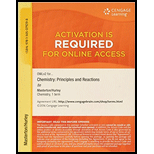
Use the following half-equations to write three spontaneous reactions. Justify your answers by calculating E° for the cells.
1.
2.
3.
Interpretation:
Using the given half-equations, the three spontaneous reactions needs to be determined by showing the value E° for the cells.
Concept introduction:
A reducing or a reductant is a species that loses electron/s and gets oxidized in the chemical reaction. The reducing agent is usually in one of its lower probable oxidation states, is recognized as the electron donor. Since, the reducing agent in the redox reaction loses electron/s, reducing agent gets oxidized.
An oxidizing agent is an agent which gains the electrons and get reduced within the chemical reaction. It is also recognized as electron acceptor; it is usually in one of its higher probable oxidation states so that it can reduce after accepting electron/s.
Spontaneity of a reaction is dependent on the free energy sign that is
Since,
Here, n = number of electrons involved in reaction and F is faraday constant.
If the value of E° for a reaction is positive, then the reaction occurs spontaneous.
Answer to Problem 39QAP
The three spontaneous reactions are as follows:
(a)
(b)
(c)
Explanation of Solution
Given Information:
The three half-equations are given as follows:
Suppose cell consisting half-equation (2) as oxidation half-reaction and half-equation (1) as reduction half-reaction.
Balancing the electrons in above two reaction and then adding the two equations to get overall cell reaction.
The value of E° for a cell is the sum of standard reduction as well as standard oxidation potentials.
Since, the value of E° for the cell is positive, the overall cell reaction is spontaneous.
Suppose cell consisting half-equation (3) as oxidation half-reaction and half-equation (1) as reduction half-reaction.
Balancing the electrons in above two reaction and then adding the two equations to get overall cell reaction.
The value of E° for a cell is the sum of standard reduction as well as standard oxidation potentials.
Since, the value of E° for the cell is positive, the overall cell reaction is spontaneous.
Suppose cell consisting half-equation (3) as oxidation half-reaction and half-equation (1) as reduction half-reaction.
Balancing the electrons in above two reaction and then adding the two equations to get overall cell reaction.
The value of E° for a cell is the sum of standard reduction as well as standard oxidation potentials.
Since, the value of E° for the cell is positive, the overall cell reaction is spontaneous.
Thus, the three spontaneous reactions will be:
(a)
(b)
(c)
Want to see more full solutions like this?
Chapter 17 Solutions
CHEMISTRY:PRIN.+REACTIONS-OWLV2 ACCESS
- For the following compound: HO -H Draw a mechanism for the tautomerization process under BASIC conditions: Mechanism A: H-O: H-OH H-O HH H-OO Mechanism B: H-Q Mechanism C: Θ OH H-O: Mechanism D: H-O H- H-OO C H-OO H- H- H-OO HH OH -H - HON H :OH H-Harrow_forwardidentify the product (or multiple products) for each of the following reactions: CI 1) NaNH2 (excess) ठ Cl 2) H₂O Hz H₂SO₂, H₂O HgSO Lindlar's catalyst 1) n-BuLi 2) 1)9-BBN 2) H₂O, NaOH ? Br H A B C afó gó H OA B O c OD E OF D E F H H Na, NHarrow_forwardIdentify the product (or multiple products) for each of the following reactions: ? or CI CI 1) NaNHz (excess) 2) H₂O OA OB O C OD OE OF H₂SO₂, H₂O Hq50. 1) n-BuLi 2) Br 1) 9-BBN 2) H₂O₂, NaOH A B H H متته D E H H H H C H H F H H H₂ Lindlar's catalyst Na NHarrow_forward
- Identify the product (or multiple products) for each of the following reactions: O A OB Oc OD OE OF CI CI 1) NaNH2 (excess) 2) H₂O H₂ H₂SO2, H₂O HgSO Lindlar's catalyst 1) n-BuLi 2) Br 1)9-BBN 2) H₂O₂, NaOH ? Na, NH3 C H A H H مننه مننه منن مننه H F H H E مند H D H Harrow_forwardFor the following compound: HO H Draw a mechanism for the tautomerization process under BASIC conditions: Mechanism A: + H-O: H-OH₂ H Mechanism B: H-Ö: HO-H H-OO -H H HH H H HH H-O: H-OO H-OO -H H e -H : OH Θ Mechanism C: Θ A : OH H-O: H H H-O-H 0. Mechanism D: e.. : OH :0 H H-O-H H-O: H-OO :O H -H H H сём H 0 :0 + H Θ H H H-arrow_forwardFor the following compound: H OH Draw a mechanism for the tautomerization process under ACIDIC conditions: Mechanism A: Θ :OH O O-H HO 0: Mechanism B: :O-H e.. Θ :OH Mechanism C: H HO-H :0: Θ 0: H H e.. : OH 0: "Θ HH O. :OH :OH O-H O-H Mechanism D: :OH H-OH₂ :OH HO-H 0: © O-H H HH 0: HHarrow_forward
 ChemistryChemistryISBN:9781305957404Author:Steven S. Zumdahl, Susan A. Zumdahl, Donald J. DeCostePublisher:Cengage Learning
ChemistryChemistryISBN:9781305957404Author:Steven S. Zumdahl, Susan A. Zumdahl, Donald J. DeCostePublisher:Cengage Learning Chemistry: Principles and PracticeChemistryISBN:9780534420123Author:Daniel L. Reger, Scott R. Goode, David W. Ball, Edward MercerPublisher:Cengage Learning
Chemistry: Principles and PracticeChemistryISBN:9780534420123Author:Daniel L. Reger, Scott R. Goode, David W. Ball, Edward MercerPublisher:Cengage Learning Chemistry: An Atoms First ApproachChemistryISBN:9781305079243Author:Steven S. Zumdahl, Susan A. ZumdahlPublisher:Cengage Learning
Chemistry: An Atoms First ApproachChemistryISBN:9781305079243Author:Steven S. Zumdahl, Susan A. ZumdahlPublisher:Cengage Learning Chemistry: The Molecular ScienceChemistryISBN:9781285199047Author:John W. Moore, Conrad L. StanitskiPublisher:Cengage Learning
Chemistry: The Molecular ScienceChemistryISBN:9781285199047Author:John W. Moore, Conrad L. StanitskiPublisher:Cengage Learning Chemistry & Chemical ReactivityChemistryISBN:9781337399074Author:John C. Kotz, Paul M. Treichel, John Townsend, David TreichelPublisher:Cengage Learning
Chemistry & Chemical ReactivityChemistryISBN:9781337399074Author:John C. Kotz, Paul M. Treichel, John Townsend, David TreichelPublisher:Cengage Learning





